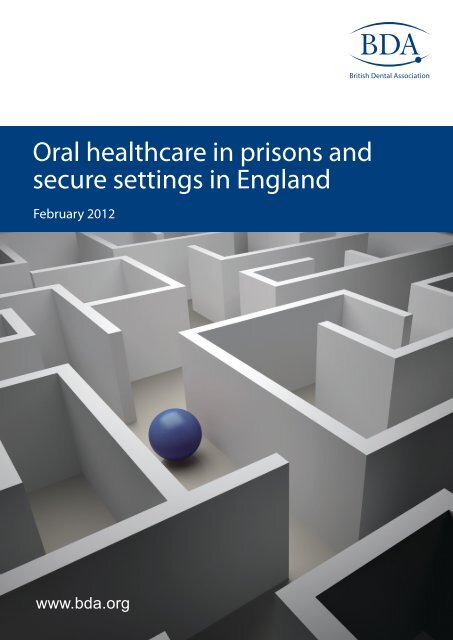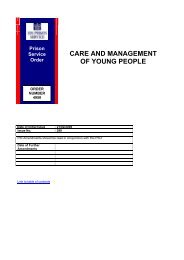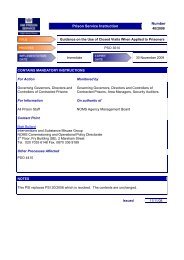Oral Health in English Prisons - Inside Time
Oral Health in English Prisons - Inside Time
Oral Health in English Prisons - Inside Time
- No tags were found...
You also want an ePaper? Increase the reach of your titles
YUMPU automatically turns print PDFs into web optimized ePapers that Google loves.
<strong>Oral</strong> healthcare <strong>in</strong> prisons andsecure sett<strong>in</strong>gs <strong>in</strong> EnglandFebruary 2012www.bda.org
technology can be <strong>in</strong>tegrated <strong>in</strong>to exist<strong>in</strong>g IT systems and <strong>in</strong>cludes dental health records.The transient nature of the prison population hampers cont<strong>in</strong>u<strong>in</strong>g dental care as well as provid<strong>in</strong>ga constant supply of new high needs patients. Given these issues, the challenge of provid<strong>in</strong>geffective dental care to prisoners is highlighted <strong>in</strong> the model shown by Harvey et al (2005:07).Demand• Demand<strong>in</strong>g consumers• Turnover of prison population• Difficulties <strong>in</strong> provid<strong>in</strong>gcont<strong>in</strong>uity of care• Interupted treatments andnon-attendanceChallenges to deliver<strong>in</strong>g careDentists and dental teams work<strong>in</strong>g <strong>in</strong> secure sett<strong>in</strong>gs are committed to provid<strong>in</strong>g this importantservice but are often not appropriately supported to deliver the care needed by their patients. TheNAPDUK guide to work<strong>in</strong>g <strong>in</strong> prisons suggests that “sometimes prison dentists and can facedifficult dilemmas when exist<strong>in</strong>g prison regimes and safe cl<strong>in</strong>ical practice do not co<strong>in</strong>cide and theirethical obligations as regulated professionals meant that they may have to challenge traditionalprison practices” (NAPDUK 2010:i). It is important the <strong>in</strong>creased regulation does not imp<strong>in</strong>ge onpatient care particularly for the vulnerable patients found <strong>in</strong> prison and secure sett<strong>in</strong>gs. It is alsoimportant that to ensure this, practitioners <strong>in</strong> such environments receive adequate support toenable the high standards of <strong>in</strong>fection control and cl<strong>in</strong>ically safe environments are reta<strong>in</strong>ed but <strong>in</strong> amanner suitable to the prison environment.BDA survey resultsNeeds• High levels of need• Long stand<strong>in</strong>g neglect <strong>in</strong> oral health• Rout<strong>in</strong>e checks and health promotiongiven less priority due to high needs• Drug misuse and smok<strong>in</strong>g <strong>in</strong>creasedental health needs• NutritionhResourcesWait<strong>in</strong>g times• Availability of dental care products• Outdated facilities and equipment• Lack of spacehhh• Lack of fund<strong>in</strong>g for health promotionand additional sessions• Insufficient staff for treatment and for security• Staff tra<strong>in</strong><strong>in</strong>g and quality assuranceSupply• Shortages <strong>in</strong> dental time• Sessions shortened bysecurity procedures• Recruitment and retention• Quality of dental care• Availability of rout<strong>in</strong>etreatment <strong>in</strong> some prisons• Availability of oral healthpromotionHarvey et al (2005:07)In 2010, the BDA embarked on a project across the UK to gather evidence from prison dentistsregard<strong>in</strong>g the challenges of work<strong>in</strong>g <strong>in</strong> the prison environment. On average, over half of thosesurveyed had worked <strong>in</strong> prison dentistry for between six and 15 years, show<strong>in</strong>g a dedication totreat<strong>in</strong>g these vulnerable members of society (BDA 2010:12). The survey results highlightedthat 64 per cent of respondents said they would like to receive more tra<strong>in</strong><strong>in</strong>g particularly aroundsecurity or cl<strong>in</strong>ical tra<strong>in</strong><strong>in</strong>g on patients with substance abuse issues. The clear message from thesurvey was that the delivery of dentistry with<strong>in</strong> the prison structure was <strong>in</strong> many ways different tohigh street dentistry and care was not as easily deliverable <strong>in</strong> secure sett<strong>in</strong>gs where <strong>in</strong>frastructurewas sometimes built pre 1900, and where security (for obvious reasons) was <strong>in</strong>flexible.What is the solution?The BDA makes these recommendations to:• M<strong>in</strong>istry of Justice• Department of <strong>Health</strong>• NHS Commission<strong>in</strong>g Board• Prison authorities• Dental Care Providers• Postgraduate Deans1. The Department of <strong>Health</strong> and the NHS Commission<strong>in</strong>g Board should ensure that prisondental healthcare services are suitably commissioned and/or contracted to ensure appropriatedental care for all.2. The M<strong>in</strong>istry of Justice, the Department of <strong>Health</strong>, the NHS Commission<strong>in</strong>g Board, Prisonauthorities and dental care providers should make clear the NHS offer and provide assistanceto dentists if cl<strong>in</strong>ical decisions are not understood or agreed with by the patient.3. The NHS Commission<strong>in</strong>g Board and the Department of <strong>Health</strong> should put <strong>in</strong> place anagreement on the appropriate wait<strong>in</strong>g time for <strong>in</strong>itial exam<strong>in</strong>ation, ongo<strong>in</strong>g rout<strong>in</strong>e care andaccess to emergency provision with an outl<strong>in</strong>e for measur<strong>in</strong>g these times.4. The Department of <strong>Health</strong> and the NHS Commission<strong>in</strong>g Board should develop an appropriatesystem for the transfer of patient oral health history <strong>in</strong> a timely manner when the patient ismoved to ensure cont<strong>in</strong>u<strong>in</strong>g care to be available to prisoners. The Department of <strong>Health</strong>recently committed to improv<strong>in</strong>g the transfer of medical records between secure sett<strong>in</strong>gs, andthe same commitment must be made for dentistry.5. The NHS Commission<strong>in</strong>g Board should establish a basel<strong>in</strong>e of exist<strong>in</strong>g practices to ensurethey are fit for purpose and appropriate resources should be allocated to correct deficiencies.6. The M<strong>in</strong>istry of Justice and the NHS Commission<strong>in</strong>g Board should ensure that the dental teamis fully <strong>in</strong>tegrated <strong>in</strong>to the prison health team and ensure open channels of communication.7. The NHS Commission<strong>in</strong>g Board, the Prison authorities and dental care providers shouldensure that all dentists and dental care professionals new to the prison environment shouldreceive a full <strong>in</strong>duction to prison security protocol and given an immediate <strong>in</strong>duction plan.Tra<strong>in</strong><strong>in</strong>g on the follow<strong>in</strong>g should form a mandatory part of the <strong>in</strong>duction process:a. general securityb. personal protectionc. situation de-escalationd. handl<strong>in</strong>g difficult prisonerse. understand<strong>in</strong>g the crim<strong>in</strong>al justice system
8. The NHS Commission<strong>in</strong>g Board and dental care providers should make all cl<strong>in</strong>icians new toprison dentistry aware of the National Association of Prison Dentistry UK handbook, Dentistry<strong>in</strong> <strong>Prisons</strong>, which gives comprehensive advice from peers.9. Postgraduate Dental Deans should make available more prison-specific cl<strong>in</strong>ical tra<strong>in</strong><strong>in</strong>gscourses on issues <strong>in</strong>clud<strong>in</strong>ga. drug misuse and the impact on oral healthb. alcohol misuse and the impact on oral healthc. deal<strong>in</strong>g with alcoholismd. management of failed/fail<strong>in</strong>g dentitione. medical emergencies <strong>in</strong> the prison environmentf. deal<strong>in</strong>g with complex drug therapyg. treatment plann<strong>in</strong>g for the transient population10. The NHS Commission<strong>in</strong>g Board should ensure that NHS contracts should be awarded <strong>in</strong> sucha way that they attract superannuation.How do decision-makers implement the solutions?Dentists and dental care professionals work<strong>in</strong>g <strong>in</strong> prisons, young offenders’ <strong>in</strong>stitutes andsecure psychiatric hospitals should be supported to deliver the high quality care they want andneed to give their patients. In England and Wales and recently <strong>in</strong> Scotland, prison dentists areaccountable to two organisations: the NHS and the prison authorities caus<strong>in</strong>g confusion for prisondentists <strong>in</strong> England and Wales about where responsibility for an issue may lay and the dentistbe<strong>in</strong>g “stuck <strong>in</strong> the middle” (BDA survey 2010:9).The recommendations we make offer a way forward to ensure that practitioners provid<strong>in</strong>g care topatients <strong>in</strong> secure sett<strong>in</strong>gs are supported to deliver appropriate care.ReferencesAudit Scotland (2008) Manag<strong>in</strong>g <strong>in</strong>creas<strong>in</strong>g prisoner numbers <strong>in</strong> ScotlandAvailable: http://www.audit-scotland.gov.uk/docs/central/2008/nr_080508_prisoner_numbers.pdfBDA (2010) Prison dentist surveyAvailable: http://www.bda.org/Images/prison_dentist_survey_report_sept_2010.pdfCrook, F. (2009) “Everybody Hurts: The social costs of the failure of prisons”. Perrie Lectures.Prison Service Journal. Issue 186, p29-31.Department of <strong>Health</strong> (2003) Strategy for Modernis<strong>in</strong>g Dental Services for Prisoners <strong>in</strong> England.Available: http://www.dh.gov.uk/prod_consum_dh/groups/dh_digitalassets/@dh/@en/documents/digitalasset/dh_4068229.pdfDepartment of <strong>Health</strong> (2011) Press release: Prison health to improve as result of nationalIT system.Available: http://www.dh.gov.uk/en/MediaCentre/Pressreleases/DH_125986Harvey, S., Anderson, B., Cantore, S., K<strong>in</strong>g, E., Malik, F. (2005) “Reform<strong>in</strong>g prison dental services<strong>in</strong> England – a guide to good practice”.Available: http://www.dh.gov.uk/en/Publicationsandstatistics/PublicationsPublicationsPolicyAndGuidance/DH_4139050Hayes, A., Shaw, J. (2011) “Practice <strong>in</strong>to Policy: The Needs of Elderly Prisoners <strong>in</strong> England andWales”. Prison Service Journal. Issue 194, p38-44.Heath, L., Iqbal, Z. (2007) “Measur<strong>in</strong>g the health status of prisoners”. Prison Service Journal.Issue 174, p42-44.Available: http://www.hmprisonservice.gov.uk/resourcecentre/prisonservicejournal/<strong>in</strong>dex.asp?id=7534,3124,11,3148,0,0HM Prison Service – Population figures to April 2011Available: http://www.hmprisonservice.gov.uk/resourcecentre/publicationsdocuments/<strong>in</strong>dex.asp?cat=85M<strong>in</strong>istry of Justice – Population figures from April 2011Available: http://www.justice.gov.uk/publications/statistics-and-data/prisons-and-probation/prisonpopulation-figures/<strong>in</strong>dex.htmNational Association of Prison Dentistry UK (2010) “Dentistry <strong>in</strong> prisons: a guide to work<strong>in</strong>g with<strong>in</strong>the prison environment”. Stephen Hancocks Ltd, London.WHO (2007) “<strong>Health</strong> <strong>in</strong> prisons; A WHO guide to the essentials <strong>in</strong> prison health”. Eds Møller, L.,Stöver, H., Jürgens, R., Gatherer., A., Nikogosian, H.Available: http://www.euro.who.<strong>in</strong>t/__data/assets/pdf_file/0009/99018/E90174.pdf
BDA64 Wimpole Street, London W1G 8YST 020 7935 0875 | F 020 7487 5232enquiries@bda.org
















